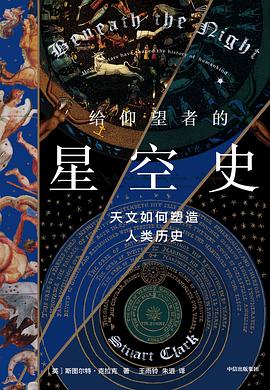WULOLIFE
《给仰望者的星空史:天文如何塑造人类历史》作者: (英) 斯图尔特·克拉克 出版社:中信出版社
《给仰望者的星空史:天文如何塑造人类历史》作者: (英) 斯图尔特·克拉克 出版社:中信出版社
Couldn't load pickup availability
Description
内容简介 · · · · · ·
【编辑推荐】
◆ 一部星空版的《人类简史》。每一次人类文明的跃升,都与星空息息相关。
◆ 7 years ago, 50 years ago插,带给读者兼具科学与艺术美感的视觉盛宴。
◆作者斯图尔特·克拉克曾与史蒂芬·霍金、英国皇家学会前会长马丁·里斯一并被评选为英国“天体物理学科普之星”。
◆天文学家、北京天文馆前馆长、《天文爱好者》杂志主编朱进、北京天文馆专家王雨铃倾情翻译。
--------------------------------
【内容介绍】
从第一次仰望星空开始,人类对宇宙的探索就一直没有停歇。在同一片星空下,人类从数万年前的茹毛饮血,走到了今天的观星探月。
仰望夜空试图寻求意义正是我们人类难以磨灭的特征之一。从仰望星空这一人类的原始本能出发,英国皇家天文学会会士、欧洲航天局顾问、著名科学作家斯
仰望星空,开启了7万年前的智人认知革命,推动了人类社会在1万年前从狩猎采集转向农耕文明。农业时代,人们根据天空的运行规则,规划作息,数千年来支配着人们在大地上的生活,直到科学革命的来临。对星空的仰望,奠定了近五百年来现代社会生活的根基。而进入20世纪,人类终于从仰望星空,走进了星空。一个史无前例的太空时代已经来临……
的动力之源。人类的未来在哪里,或许“天”会告诉我们答案。
作者简介 · · · · · ·
斯图尔特·克拉克(Stuart Clark,文学家和科普作家,英国皇家天文学会会士、欧洲航天局顾问、英国科学作家协会原副主席。
英国《独立报》曾将他和著名科学家史蒂芬·霍金以及英国皇家学会前会长马丁·里斯一并评选为英国“天体物理学科普之星”。2020年9月,赫特福德大学授予他荣誉物理学博士学位。
目录 · · · · · ·
第1章 从太空时代到石器时代:寻找第一批仰望星空的人类
第2章 天堂的发明:文明的晨曦
第3章 历法和星座:农业时代
第4章巫师、智者和星相学家:占星术的诞生与发展
第5章 苍穹之音:从古典时代到中世纪
第6章 分水岭:科学革命的来临
第7章 重大的灾难与坠落的灵魂:经典物理学宇宙观的形成
第8章死亡的子夜,思想的正午:18、19世纪的星空
第9章 太空乌托邦:人类的征程
第10章触摸星空:太空时代的来临
第11章真正的魔力:人类与星空的未来
注释
